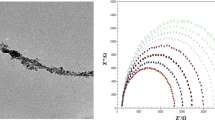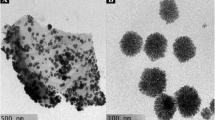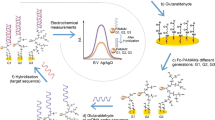Abstract
In this paper, a novel direct DNA electrochemical biosensor was developed for detection of breakpoint cluster region gene and the cellular abl (BCR/ABL) fusion gene from chronic myelogenous leukemia. Nanosized ZnO was first immobilized on the surface of a carbon paste electrode, and then poly(indole-5-carboxylic acid) (PICA), a new electroactive material, was electropolymerized on the ZnO substrate by using the potentiostatic method to form a unique nanocomposite structure. The obtained PICA/ZnO nanocomposite not only served as a substrate for DNA immobilization but also reflected the electrochemical transduction originating from DNA immobilization and hybridization without any outer indicators or complicated labeling. The immobilization of probe DNA was successfully conducted via covalent bonding between the abundant carboxyl groups of PICA/ZnO nanocomposite film and amino groups at the 5′-end of probe DNA. After the hybridization of probe DNA with target DNA, the formation of double-helix structure induced the “signal-on” of the nanocomposite. The dynamic range of this DNA biosensor for detecting the complementary target sequence of BCR/ABL fusion gene was from 1.0 × 10−15 to 1.0 × 10−9 mol/L using electrochemical impedance spectroscopy, and the detection limit was estimated to be 2.2 × 10−16 mol/L.





Similar content being viewed by others
References
Sassolas A, Leca-Bouvier BD, Blum LJ (2008) DNA biosensors and microarrays. Chem Rev 108:109–139
Liu AL, Wang K, Weng SH, Lei Y, Lin LQ, Chen W, Lin XH, Chen YZ (2012) Development of electrochemical DNA biosensors. Trends Anal Chem 37:101–111
Benvidi A, Rajabzadeh N, Zahedi HM, Mazloum-Ardakani M, Heidari MM, Hosseinzadeh L (2015) Simple and label-free detection of DNA hybridization on a modified graphene nanosheets electrode. Talanta 137:80–86
Li B, Pan GH, Avent ND, Lowry RB, Madgett TE, Waines PL (2015) Graphene electrode modified with electrochemically reduced graphene oxide for label-free DNA detection. Biosens Bioelectron 72:313–319
Li JF, Lee EC (2015) Carbon nanotube/polymer composite electrodes for flexible, attachable electrochemical DNA sensors. Biosens Bioelectron 71:414–419
Rasheed PA, Sandhyarani N (2015) A highly sensitive DNA sensor for attomolar detection of the BRCA1 gene: signal amplification with gold nanoparticle clusters. Analyst 140:2713–2718
Fayazfar H, Afshar A, Dolati M, Dolati A (2014) DNA impedance biosensor for detection of cancer, TP53 gene mutation, based on gold nanoparticles/aligned carbon nanotubes modified electrode. Anal Chim Acta 836:34–44
Tiwari I, Singh M, Pandey CM, Sumana G (2015) Electrochemical genosensor based on graphene oxide modified iron oxide-chitosan hybrid nanocomposite for pathogen detection. Sens Actuators B 206:276–283
Patel MK, Ali MA, Srivastava S, Agrawal VV, Ansari SG, Malhotra BD (2013) Magnesium oxide grafted carbon nanotubes based impedimetric genosensor for biomedical application. Biosens Bioelectron 50:406–413
Yang T, Meng L, Wang XX, Wang LL, Jiao K (2013) Direct electrochemical DNA detection originated from the self-redox signal of sulfonated polyaniline enhanced by graphene oxide in neutral solution. ACS Appl Mater Interfaces 5:10889–10894
Fang LX, Huang KJ, Zhang BL, Liu B, Liu YJ, Zhang QY (2014) Nanosheet-based 3D hierarchical ZnO structure decorated with Au nanoparticles for enhanced electrochemical detection of dopamine. RSC Adv 4:48986–48993
Palanisamy S, Karuppiah C, Chen SM, Periakaruppan P (2014) A highly sensitive and selective enzymatic biosensor based on direct electrochemistry of hemoglobin at zinc oxide nanoparticles modified activated screen printed carbon electrode. Electroanalysis 26:1984–1993
Wang YT, Wang S, Tao L, Min Q, Xiang J, Wang QM, Xie JM, Yue Y, Wu SC, Li XF, Ding H (2015) A disposable electrochemical sensor for simultaneous determination of norepinephrine and serotonin in rat cerebrospinal fluid based on MWNTs-ZnO/chitosan composites modified screen-printed electrode. Biosens Bioelectron 65:31–38
Ahmad R, Tripathy N, Jang NK, Khang G, Hahn YB (2015) Fabrication of highly sensitive uric acid biosensor based on directly grown ZnO nanosheets on electrode surface. Sens Actuators B 206:146–151
Park J, You XQ, Jang Y, Nam Y, Kim MJ, Min NK, Pak JJ (2014) ZnO nanorod matrix based electrochemical immunosensors for sensitivity enhanced detection of Legionella pneumophila. Sens Actuators B 200:173–180
Hershkovitz-Rokah O, Modai S, Pasmanik-Chor M, Toren A, Shomron N, Raanani P, Shpilberg O, Granot G (2015) MiR-30e induces apoptosis and sensitizes K562 cells to imatinib treatment via regulation of the BCR-ABL protein. Cancer Lett 356:597–605
Talbi H, Billaud D, Louarn G, Pron A (2001) In-situ spectroscopic investigations of the redox behavior of poly(indole-5-carboxylic-acid) modified electrodes in acidic aqueous solutions. Spectrochim Acta Part A 57:423–433
Maciejewska J, Pisarek K, Bartosiewicz I, Krysinski P, Jackowska K, Biegunski AT (2011) Selective detection of dopamine on poly(indole-5-carboxylic acid)/tyrosinase electrode. Electrochim Acta 56:3700–3706
Zhang W, Yang T, Li X, Wang DB, Jiao K (2009) Conductive architecture of Fe2O3 microspheres/self-doped polyaniline nanofibers on carbon ionic liquid electrode for impedance sensing of DNA hybridization. Biosens Bioelectron 25:428–434
Pham MC, Piro B, Tran LD (2003) Direct electrochemical detection of oligonucleotide hybridization on poly(5-hydroxy-1,4-naphthoquinone-co-5-hydroxy-3-thioacetic acid-1,4-naphthoquinone) film. Anal Chem 75:6748–6752
Gooding JJ, Chou A, Mearns FJ, Wong E, Jericho KL (2003) The ion gating effect: using a change in flexibility to allow label free electrochemical detection of DNA hybridisation. Chem Commun 1938–1939
Bonanni A, del Valle M (2010) Use of nanomaterials for impedimetric DNA sensors: a review. Anal Chim Acta 678:7–17
Hu LH, Tan TT, Chen G, Zhang K, Zhu JJ (2013) Ultrasensitive electrochemical detection of BCR/ABL fusion gene fragment based on polymerase assisted multiplication coupling with quantum dot tagging. Electrochem Commun 35:104–107
Wang L, Hua EH, Liang M, Ma CX, Liu ZL, Sheng SC, Liu M, Xie GM, Feng WL (2014) Graphene sheets, polyaniline and AuNPs based DNA sensor for electrochemical determination of BCR/ABL fusion gene with functional hairpin probe. Biosens Bioelectron 51:201–207
Zhong GX, Ye JX, Bai FQ, Fu FH, Chen W, Liu AL, Lin XH, Chen YZ (2014) Electrochemical biosensor for detection of BCR/ABL fusion gene based on isorhamnetin as hybridization indicator. Sens Actuators B 204:326–332
Acknowledgments
This work was supported by the National Natural Science Foundation of China (No. 21205057, 21375057) and the Doctoral Fund and Scientific Research Project of Linyi University.
Author information
Authors and Affiliations
Corresponding author
Electronic supplementary material
Below is the link to the electronic supplementary material.
ESM 1
(DOC 619 kb)
Rights and permissions
About this article
Cite this article
Zhang, W. Poly(indole-5-carboxylic acid)-functionalized ZnO nanocomposite for electrochemical DNA hybridization detection. J Solid State Electrochem 20, 499–506 (2016). https://doi.org/10.1007/s10008-015-3071-9
Received:
Revised:
Accepted:
Published:
Issue Date:
DOI: https://doi.org/10.1007/s10008-015-3071-9




